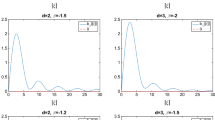Abstract
The aim of this work is to study the solution of the smoothed particle hydrodynamics (SPH) discrete formulation of the hydrostatic problem with a free surface. This problem, in which no time dependency is considered, takes the form of a system of linear equations. In particular, the problem in one dimension is addressed. The focus is set on the convergence when both the particle spacing and the smoothing length tend to zero by keeping constant their ratio. Values of this ratio of the order of one, corresponding to a limited number of neighbors, are of practical interest. First, the problem in which each particle has one single neighbor at each side is studied. The explicit expressions of the numerical solution and the quadratic error are provided in this case. The expression of the quadratic error demonstrates that the SPH solution does not converge to the exact one in general under the specified conditions. In this case, the error converges to a residue, which is in general large compared to the norm of the exact solution. The cases with two and three neighbors are also studied. An analytical study in the case of two neighbors is performed, showing how the kernel influences the accuracy of the solution through modifying the condition number of the referred system of linear equations. In addition to that, a numerical investigation is carried out using several Wendland kernel formulas. When two and three neighbors are involved it is found that the error tends in most cases to a small limiting value, different from zero, while divergent solutions are also found in the case of two neighbors with the Wendland Kernel C2. Other cases with more neighbors are also considered. In general, the Wendland Kernel C2. turns out to be the worst choice, as the solution is divergent for certain values of the ratio between the particle spacing and the smoothing length, associated with an ill-conditioned matrix.
Similar content being viewed by others
References
Di Lisio R., Grenier E., Pulvirenti M. The convergence of the SPH method [J]. Computers and Mathematics with Applications, 1998, 35(1–2): 95–102.
Evers J. H., Zisis I. A., van der Linden B. J. et al. From continuous mechanics to SPH particle systems and back. Systematic derivation and convergence [J]. ZAMM Zeitschrift fur Angewandte Mathematik und Mechanik, 2018, 98(1): 106–133.
Lisio R. D. A particle method for a self gravitating fluid [J]. Mathematical Methods in the Applied Sciences, 1995, 18(13): 1083–1094.
Vila J. On particle weighted methods and smooth particle hydrodynamics [J]. Mathematical Models and Methods in Applied Sciences, 1999, 9(2): 161–209.
Franz T., Wendland H. Convergence of the smoothed particle hydrodynamics method for a specific barotropic fluid flow: Constructive kernel theory [J]. SIAM Journal on Mathematical Analysis, 2018, 50(5): 4752–4784.
Macià F., Antuono M., González L.M., Colagrossi A. Theoretical analysis of the no- slip boundary condition enforcement in SPH methods [J]. Progress of Theoretical Physics, 2011, 125(6): 1091–1121.
Violeau D., Rogers B. D. Smoothed particle hydrodynamics (SPH) for free-surface flows: past, present and future [J]. Journal of Hydraulic Research, 2016, 54(1): 1–26.
Colagrossi A., Antuono M., Le Touzé D. Theoretical considerations on the free-surface role in the smoothed-particle-hydrodynamics model [J]. Physical Review E, 2009, 79(5): 056701.
Macià F., Merino-Alonso P., Souto-Iglesias A. On the truncated integral SPH solution of the hydrostatic problem [J]. Journal of Computational Particle Mechanics. (in Press).
Bouscasse B., Colagrossi A., Marrone S. et al. Nonlinear water wave interaction with floating bodies in SPH [J]. Journal of Fluids and Structures, 2013, 42: 112–129.
Bouscasse B., Colagrossi A., Marrone S. et al. SPH modeling of viscous flow past a circular cylinder interacting with a free surface [J]. Computers and Fluids, 2017, 146: 190–212.
Violeau D. Dissipative forces for Lagrangian models in computational fluid dynamics and application to smoothed-particle hydrodynamics [J]. Physical Review E, 2009, 80: ID036705.
Lind S. J., Stansby P. High-order eulerian incompressible smoothed particle hydrodynamics with transition to lagrangian free-surface motion [J]. Journal of Computational Physics, 2016, 326: 290–311.
Gingold R., Monaghan J. Smoothed particle hydrodynamics: theory and application to non-spherical stars [J]. Monthly Notices of the Royal Astronomical Society, 1977, 181(3): 375–389.
Wendland H. Piecewise polynomial, positive definite and compactly supported radial functions of minimal degree [J]. Advances in Computational Mathematics, 1995, 4: 389–396.
Acknowledgements
This work was supported by the Spanish ministry of Innovation and Universities (MCIU) (Grants Nos. MTM2017-85934-C3-3-P, RTI2018-096791-B-C21, “Hidrodinámica de elementos de amortiguamiento del movimiento de aerogeneradores flotantes”), P.E. Merino-Alonso is supported during the completion of his Ph. D. Thesis by MeyFP (Grant No. FPU17/05433).
Author information
Authors and Affiliations
Corresponding author
Additional information
Biography: Pablo Eleazar Merino-Alonso (1991-), Male, Ph. D. Candidate
Rights and permissions
About this article
Cite this article
Merino-Alonso, P.E., Macià, F. & Souto-Iglesias, A. On the numerical solution to the truncated discrete SPH formulation of the hydrostatic problem. J Hydrodyn 32, 699–709 (2020). https://doi.org/10.1007/s42241-020-0043-z
Received:
Revised:
Accepted:
Published:
Issue Date:
DOI: https://doi.org/10.1007/s42241-020-0043-z




